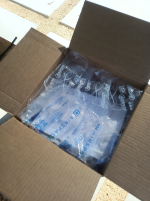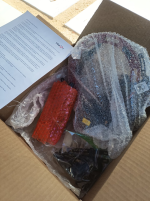A few notes from the inaugural run with the BikeOn on my Canyon Roadlite 6 street/gravel bike:
- it works on my bike
- set to 20% support, it already met two of my goals:
- allow 20 mph on flat ground while bringing heart rate into the 135 - 145 bpm range (from 150-160)
- compensate for headwind: going south, there was a 6-7 mph headwind, and the system dealt with that easily at the 20% setting
- at 45% support, it effortlessly propels me at 25 mph+, which in my humble opinion is a bit fast without protective clothing; this might depend on how fast your skin heals...
I find it hard to judge how proportional (to human power input) the system is, but at the 20% setting the startup is very smooth, without any feeling that the bike or motor is getting away from you (I've experienced harsh starts on mid-motor e-mountain bikes, especially when trying to start uphill at a higher support setting).
The acceleration to 20 mph works very smooth and feels natural, with just the right amount of motor support as you increase the cadence and switch through the gears.
Going at a continuous speed of 20 mph feels also very smooth. This while I was putting in the power needed without motor for ~15 mph. On the way back north I checked that setting the support to 'None' (which keeps enough torque on the motor to overcome the braking torque of motor & belt) gives about the right speed, of 20 mph in this case with about 6-7 mph tailwind, maybe just a smidgen faster than without the system.
The 15 mile ride used about 2V or 13% of the 700Wh battery capacity, so about 6 Wh/mile.
I still have to test the uphill support capabilities.
A few pics:


It arrived well packaged.

All the components and spare parts it came with:

Installed on my bike, at the halfway point of a 15 mile ride:

I'll comment later on the installation process. This might have been the first 11 speed street cassette this system has been installed on.
Aram was extremely supportive, he made an installation video on one particular aspect just for me, and we exchanged several emails and spoke on the phone over the last two days.












